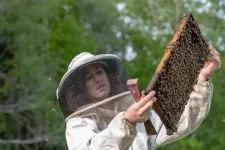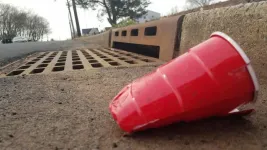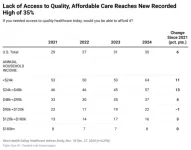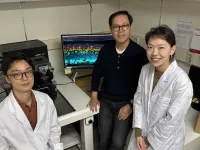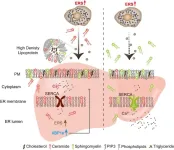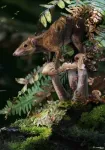(Press-News.org) An AI model trained on large amounts of genetic data can predict whether bacteria will become antibiotic-resistant. The new study shows that antibiotic resistance is more easily transmitted between genetically similar bacteria and mainly occurs in wastewater treatment plants and inside the human body.
"By understanding how resistance in bacteria arises, we can better combat its spread. This is crucial to protect public health and the healthcare system's ability to treat infections," says Erik Kristiansson, Professor at the Department of Mathematical Sciences at Chalmers University of Technology and the University of Gothenburg in Sweden.
Antibiotic resistance is one of the biggest threats to global health, according to the World Health Organization (WHO). When bacteria become resistant, the effect of antibiotics disappears, which makes conditions such as pneumonia and blood poisoning difficult or impossible to treat. Increased antibiotic-resistant bacteria also make it more difficult to prevent infections associated with many medical procedures, such as organ transplantation and cancer treatment. A fundamental reason for the rapid spread of antibiotic resistance is bacteria's ability to exchange genes, including the genes that make the bacteria resistant.
"Bacteria that are harmful to humans have accumulated many resistance genes. Many of these genes originate from harmless bacteria that live in our bodies or the environment. Our research examines this complex evolutionary process to learn how these genes are transferred to pathogenic bacteria. This makes predicting how future bacteria develop resistance possible," says Erik Kristiansson.
Complex data from all over the world
In the new study, published in Nature Communications and conducted by researchers at the Chalmers University of Technology, the University of Gothenburg, and the Fraunhofer-Chalmers Centre, the researchers developed an AI model to analyse historical gene transfers between bacteria using information about the bacteria's DNA, structure, and habitat. The model was trained on the genomes of almost a million bacteria, an extensive dataset compiled by the international research community over many years.
"AI can be used to the best of its ability in complex contexts, with large amounts of data," says David Lund, doctoral student at the Department of Mathematical Sciences at Chalmers and the University of Gothenburg. “The unique thing about our study is, among other things, the very large amount of data used to train the model, which shows what a poweful tool AI and machine learning is for describing the complex, biological processes that make bacterial infections difficult to treat”.
New conclusions about when antibiotic resistance arises
The study shows in which environments the resistance genes were transferred between different bacteria, and what it is that makes some bacteria more likely than others to swap genes with each other.
"We see that bacteria found in humans and water treatment plants have a higher probability of becoming resistant through gene transfer. These are environments where bacteria carrying resistance genes encounter each other, often in the presence of antibiotics," says David Lund.
Another important factor that increases the likelihood that resistance genes will "jump" from one bacterium to another is the genetic similarity of the bacteria. When a bacterium takes up a new gene, energy is required to store the DNA and produce the protein that the gene codes for, which means a cost for the bacterium.
"Most resistance genes are shared between bacteria with a similar genetic structure. We believe that this reduces the cost of taking up new genes. We are continuing the research to understand the mechanisms that control this process more precisely," says Erik Kristiansson.
Hoping for a model for diagnostics
The model's performance was tested by evaluating it against bacteria, where the researchers knew that the transfer of resistance genes had occurred, but where the AI model was not told in advance. This was used as a kind of exam, where only the researchers had the answers. In four cases out of five, the model could predict whether a transfer of resistance genes would occur. Erik Kristiansson says that future models will be able to be even more accurate, partly by refining the AI model itself and partly by training it on even larger data.
"AI and machine learning make it possible to efficiently analyse and interpret the enormous amounts of data available today. This means that we can really work data-driven to answer complex questions that we have been wrestling with for a long time, but also ask completely new questions”, says Erik Kristiansson.
The researchers hope that in the future, the AI model can be used in systems to quickly identify whether a new resistance gene is at risk of being transferred to pathogenic bacteria, and translate this into practical measures.
"For example, AI models could be used to improve molecular diagnostics to find new forms of multi-resistant bacteria or for monitoring wastewater treatment plants and environments where antibiotics are present," says Erik Kristiansson.
More about the study:
The study, Genetic compatibility and ecological connectivity drive the dissemination of antibiotic resistance genes, was published in Nature Communications.
The study was conducted by David Lund, Marcos Parras-Moltó, Juan S. Inda-Díaz, Stefan Ebmeyer, ProfileD.G. Joakim Larsson, Anna Johnning, Erik Kristiansson. The researchers are active at Chalmers University of Technology, the University of Gothenburg and the Fraunhofer-Chalmers Centre.
For more information, please contact:
David Lund, PhD student, Department of Mathematical Sciences, Chalmers University of Technology and University of Gothenburg: dlund@chalmers.se
Erik Kristiansson, Professor, Department of Mathematical Sciences, Chalmers University of Technology and University of Gothenburg: +46 31 772 3521 erik.kristiansson@chalmers.se
All photo cred: Chalmers University of Technology
The researchers speak Swedish and English and can be available for live and pre-recorded interviews. At Chalmers, we have podcast studios and film equipment on site and can assist requests for TV, radio or podcast interviews.
END
Multi-resistance in bacteria predicted by AI model
2025-04-02
ELSE PRESS RELEASES FROM THIS DATE:
Tinker Tots: A citizen science project to explore ethical dilemmas in embryo selection
2025-04-02
EMBARGOED UNTIL 09:00 BST WEDNESDAY 2 APRIL
Tinker Tots: A Citizen Science Project to Explore Ethical Dilemmas in Embryo Selection
Researchers at the University of Oxford, University of Exeter, and the National University of Singapore Yong Loo Lin School of Medicine present a new, interactive study.
Oxford, 2 April 2025: When choosing an embryo for implantation during in vitro fertilization (IVF), would you consider its chances of developing a health condition? What about traits like creativity, intelligence, ...
Sensing sickness
2025-04-02
Beekeepers in the United States lost more than 55 percent of managed colonies last year—the highest loss rate since the Apiary Inspectors of America began determining them in 2011. A new study from University of Vermont scientists and international collaborators supports a novel method for testing hygienic behavior in honey bees that could promote breeding more disease resistant colonies in the future.
“Beekeepers are losing bees at a rate that they say is unsustainable,” says Samantha Alger, director of the Vermont Bee Lab at the UVM and lead author of the study. “In the ‘80s, beekeepers lost colonies ...
Cost to build multifamily housing in California more than twice as high as in Texas
2025-04-02
Building multifamily housing in California is more than twice as expensive as it is in Texas, with much of the difference driven by state and local policies that contribute to long permitting and construction timelines, and higher local development fees, according to a new RAND report based on cost information from more than 100 completed apartment projects.
The high cost of housing and its associated effect on homelessness is a defining policy issue in California.
The cost of building multifamily housing is 2.3 times higher in California than Texas and 1.5 times higher than in Colorado, ...
Program takes aim at drinking, unsafe sex, and sexual assault on college campuses
2025-04-02
PISCATAWAY, NJ – A prevention program that teaches college students about the links between risky drinking and sexual assault—and how to protect themselves and their friends—has shown early promise, according to a new report in the Journal of Studies on Alcohol and Drugs.
It’s well known that alcohol and sex can sometimes be a dangerous mix for young adults. Alcohol intoxication raises the odds of having unprotected sex and, possibly, contracting a sexually transmitted disease or having an unplanned pregnancy. Drinking can also increase the risk of falling victim to sexual assault or becoming the perpetrator.
Yet college prevention programs have traditionally ...
Inability to pay for healthcare reaches record high in U.S.
2025-04-02
WASHINGTON, D.C. – April 2, 2025 – The inability to pay for healthcare in the U.S. has reached a new high, with more than one-third of Americans (35%), or an estimated 91 million people, reporting that they could not access quality healthcare if they needed it today, according to the latest West Health-Gallup Healthcare Affordability Index. The Index has been tracking healthcare affordability and access in the U.S. since 2021.
Rates were higher among Black and Hispanic Americans, with 46% and 52%, respectively, reporting ...
Science ‘storytelling’ urgently needed amid climate and biodiversity crisis
2025-04-02
Scientists should experiment with creative ways of communicating their work to inspire action to protect the natural world, researchers say.
Scientists primarily publish their work in academic journals, where writing is expected to be technical, objective and dispassionate – making it unlikely to appeal to, or be easily understood by non-experts.
The researchers – from the University of Exeter – argue for science “translated into stories”, with benefits both for science and wider society.
They suggest ways that scientists can tell powerful, passionate stories without compromising the objectivity of science.
“As ...
KAIST Develops Retinal Therapy to Restore Lost Vision
2025-04-02
Vision is one of the most crucial human senses, yet over 300 million people worldwide are at risk of vision loss due to various retinal diseases. While recent advancements in retinal disease treatments have successfully slowed disease progression, no effective therapy has been developed to restore already lost vision—until now. KAIST researchers have successfully developed a novel drug to restore vision.
< Photo 1. (From left) Ph.D. candidate Museong Kim, Professor ...
Adipocyte-hepatocyte signaling mechanism uncovered in endoplasmic reticulum stress response
2025-04-02
The endoplasmic reticulum (ER) is the portion of the cell responsible for manufacturing and folding proteins. Proteins are essential for a wide range of cellular functions—as enzymes, transporters, hormones, antibodies, receptors, and more. They must be folded into the correct three-dimensional shape to function properly. If the ER is unable to manufacture or fold proteins correctly, the cell develops ER stress, which activates the unfolded protein response (UPR)—a protective mechanism aimed at restoring cellular function.
While UPR begins ...
Mammals were adapting from life in the trees to living on the ground before dinosaur-killing asteroid
2025-04-02
More mammals were living on the ground several million years before the mass extinction event that wiped out the dinosaurs, new research led by the University of Bristol has revealed.
The study, published today in the journal Palaeontology, provides fresh evidence that many mammals were already shifting toward a more ground-based lifestyle leading up to the asteroid’s impact.
By analysing small-fossilised bone fragments, specifically end of limb bones, from marsupial and placental mammals found in Western North America - the only place with a well-preserved terrestrial fossil record from this time – the team discovered signs that ...
Low LDL cholesterol levels linked to reduced risk of dementia
2025-04-01
People with low levels of low-density lipoprotein cholesterol (LDL-C) in their blood have a lower risk of dementia, including lower risk of Alzheimer’s disease related dementia, shows a study published online today in the Journal of Neurology Neurosurgery & Psychiatry.
Use of statins conveyed an additional protective effect for people with low LDL-C, specifically those with blood levels less than 1.8 mmol/L (<70 mg/dL), reducing their risk of dementia even further.
However, reducing LDL-C ...


